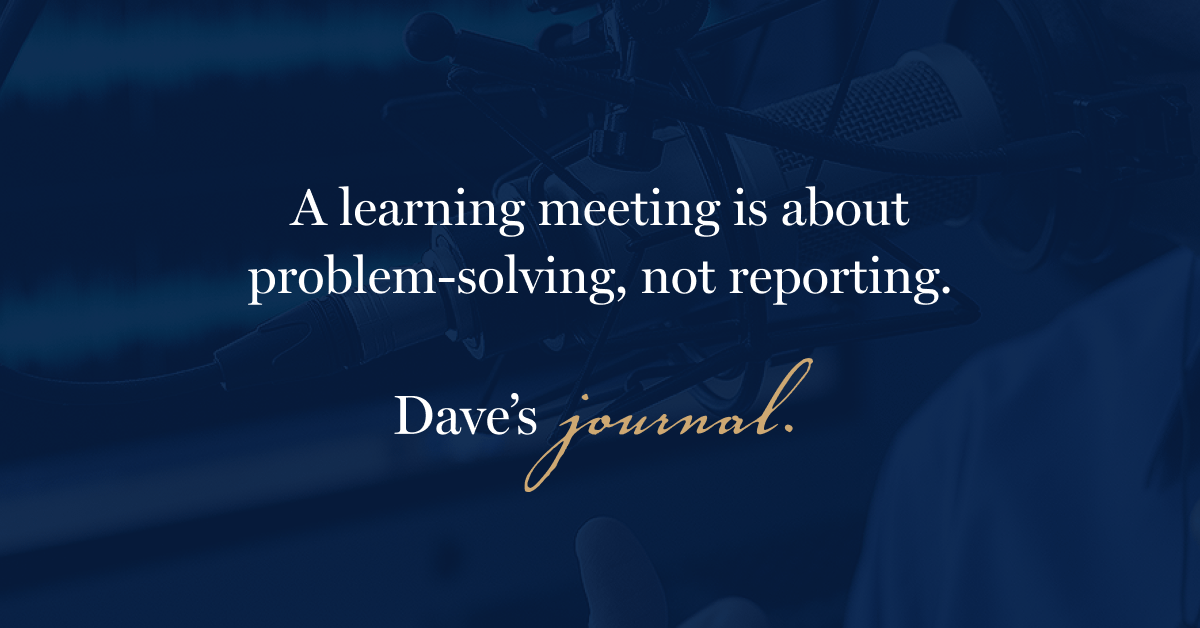There have been many meetings I have attended in my professional life that have not lived up to the intention that was hoped for when someone first put that meeting on the calendar.
No meeting is more likely to cause this kind of disappointment than the standing meeting. This is the staff meeting when we all get together at 10am on Tuesday mornings because, well…because we always get together at 10am on Tuesday mornings.
A lot of people get frustrated with standing meetings because they can easily degenerate into glorified reporting sessions.
This sounds like everyone going around the room and mostly talking about what’s happened in the last week and what they are doing for the next week. Then, everyone disperses to go about their work, only to repeat the process next week.
How do you know if you’re guilty of this? If you or someone on your team started the agenda for the next meeting by duplicating the Microsoft Word document from the last meeting and just changing a few words, you may be facilitating a glorified reporting session.
I used to have little sympathy for managers who ran these kind of meetings. However, as time has gone on and I’ve worked with more and more leaders who tell me their side of the story, I’ve come to two conclusions:
First, in some organizations, it’s simply an expectation (if not a directive) to get people together at some regular interval.
Second, I’ve realized that a lot of people have literally never seen another way to run a standing meeting.
If you find yourself in this place, especially if you’re the person leading the meeting, here’s another way to approach this. Instead of having a standing meeting, hold a learning meeting.
A learning meeting is about problem-solving, not reporting. A good learning meeting will get people motivated to engage and walking out doing something better.
Here’s the structure of what a learning meeting might look like.
- Each attendee talks about a recent accomplishment.
- Each attendee shares something they’ve discovered recently that might help others in the room.
- Each attendee says where they would like or need assistance right now.
Let’s break this down…
Starting by asking people to talk about a recent accomplishment has two benefits. It encourages people to talk, since most people are more comfortable talking about what they’ve done well vs. where they failed. It also raises the energy in the room by reminding people what’s working.
Asking each person to then do the second thing, sharing something they’ve discovered recently that might help others, gives people permission to do something that most already like to do: share something cool you’ve discovered with other people. It also encourages generosity by asking people to take an action is the interest of everyone else in the room. Each person benefits from something they’ve likely not heard or considered before.
Finally, by asking people where they would like assistance right now, you zero in on where they need new learning. Others in the meeting can then offer to help.
If you really want to double down on helping, each time you meet go into detail on having the whole group collaborate to help one person specifically. Then rotate to a new person each time.
Yes, this requires a level of trust with the group. If that trust isn’t there today, this is modular, so you can start small. Begin the next few meetings just by asking people just to share a recent accomplishment – and gradually work the other pieces in, as people get more comfortable.
If you are willing to run a learning meeting, you’ll get more dialogue and energy during the event. More importantly, people will walk away with something they can use, immediately.
Dave's Journal is available by audio on Apple Podcasts, Google Podcasts, Overcast, Stitcher, and Spotify.





